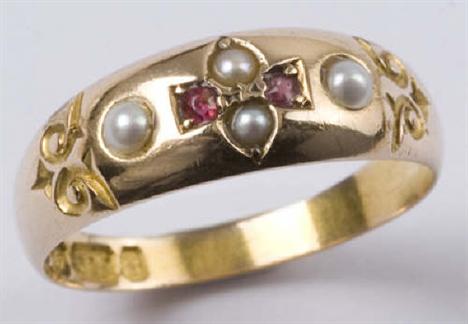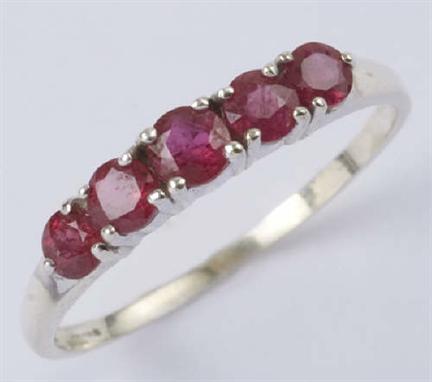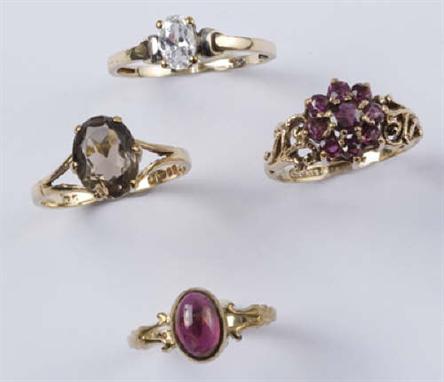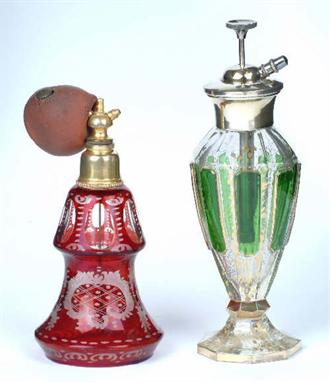We found 124080 price guide item(s) matching your search
There are 124080 lots that match your search criteria. Subscribe now to get instant access to the full price guide service.
Click here to subscribe- List
- Grid
-
124080 item(s)/page
A Pilkington's Lancastrian wall plate by William S Mycock, painted with a galleon at full sail, inside floral border, in shades of ruby and copper lustre on a blue ground impressed marks, painted artists monogram and a wreath date code, possibly 1916, repaired small chip to front of rim 25.5cm. diam.
Ladies' ruby & diamond ring, comprising twelve channel set, graduated baguette cut rubies with curved band of eleven milli-grain set, graduated brilliant cut diamonds, total weight 0.26 carats, to either edge, set in crib with ornate pierced under-bezel, all in white gold, 18ct h/m, size N or 6.1/2 US (4.4g)
Stone set bracelet, comprising eleven rectangular red stones, each with a round white stone set at the side, fitted with snap fastener, a ladies'/gent's ring set with round lilac stone in centre, three small white stones down either side & various loose stones, comprising amber, amethyst, citrine, emerald, peridot, sapphire, white topaz, star ruby & star sapphire, stones are in various cuts & 10mm or smaller (12)
* A seven stone diamond cluster ring, the brilliants totalling approximately 0.15 carats, to an 18 carat gold mount, finger size O; a Victorian ruby and diamond five stone ring, finger size J; a dress ring with a swivelling two sided stone set flower motif, stamped '18k', finger size K; and two other stone set dress rings To be sold on behalf of the Metropolitan Police (8DS25118) and is subject to VAT on the hammer priceBest Bid
* A diamond and ruby dress ring, stamped '14k', finger size L1/2; an aquamarine dress ring, finger size N; a single stone dress ring; a puzzle ring; a wedding ring; a dress ring and two toe rings To be sold on behalf of the Metropolitan Police (3DC25118) and is subject to VAT on the hammer priceBest Bid
A pair of Victorian silver bon-bon dishes with covers, Robert Garrard, London 1874-75. the shallow bowls with reticulated C-scroll formed panels with foliate detail to points and shoulders, with applied garlands of flower heads, the rim formed of scrolls, the interior with ruby glass liner, the pull-off domed covers decorated with chased panels of cross hatched designs within C-scroll cartouches, the matt ground with foliate and scroll details, the domed centre with figural finial of a young boy with rose head garland, the whole raised on a slender baluster knopped stem with spiralled branch and flower heads on a spreading shaped circular base with heavy foliate and scroll edges decorated with sprays of rose and flower heads (2), 32cm high, 60oz each
An early Victorian monumental campana-shaped vase, John Samuel Hunt, London 1848-49. the rock work and scroll base on four shell and scroll work feet, C-scroll supports and engraved crest to one panel, inscription to another, with a naturalistic base with vine tendrils crossed and knotted supporting the campana-shaped cooler of open form with vine leaves and bunches of grapes, similar cast vine leaf border, with a ruby glass liner (2), 67cm high, 39cm diameter, 472oz, Heraldry: The base with a crest and armorial for D’Eyncourt, Note: The other two cartouches engraved: ‘Presented on the 22nd June 1853 by the electors of the Metropolitan Borough of Lambeth to the Right Honourable Charles Tennyson D’Eyncourt their representative for twenty years in the first five Parliaments After their disenfranchisement in 1832’ and ‘A tribute of affectionate attachment and esteem for his private worth of respect for his patriotic and independent character and of gratitude for his able consistent and faithful services in the cause of civil religious commercial freedom throughout a Parliamentary career of thirty four years’. George Tennyson (his father) owned about one third of the land at Tealby. He lived at the original thatched Bayons Manor until 1833, two years before his death. His second son, Charles, persuaded him to add a codicil to his will so that he could be called Charles Tennyson d’Eyncourt, and claim descendancy from Norman Barons. Charles was an M.P. for 34 years. After his father’s death he took seven years to build the sixty-roomed romantic Gothic-styled Bayons Manor at enormous cost. Charles died in 1861. His descendants lived at Bayons until the Second World War. It was occupied by troops during the war and was sold in 1944. After many years of neglect it was finally blown up in 1964. See Christie’s, London, 12th May 1993, lot 49, for a very similar but smaller vase. The base with a crest and armorial for, The other two cartouches engraved;, 'Presented on the 22nd June 1853 by the electors of the Metropolitan Borough of Lambeth to the Right Honourable Charles Tennyson D'Eyncourt their representative for twenty years in the first five Parliaments After their disenfranchisement in 1832', and;, 'A tribute of affectionate attachment and esteem for his private worth of respect for his patriotic and independent character and of gratitude for his able consistent and faithful services in the cause of civil religious commercial freedom throughout a Parliamentary career of thirty four years', George Tennyson (His father) owned about one third of the land at Tealby. He lived at the original thatched Bayons Manor until 1833, two years before his death. His second son, Charles, persuaded him to add a codicil to his will so that he could be called Charles Tennyson d'Eyncourt, and claim descendancy from Norman Barons. Charles was an M.P. for 34 years. After his father's death he took seven years to build the sixty-roomed Romantic Gothic styled Bayons Manor at enormous cost. Charles died in 1861. His descendants lived at Bayons until the Second World War. It was occupied by troops during the war and was sold in 1944. After many years of neglect it was finally blown up in 1964. See Christie's, London, 12th May 1993, lot 49 for a very similar but smaller vase
A pair of American silver coloured novelty mustard pots modelled as military side drums by R. Blackington & Co., North Attleboro, Mass., the covers with crossed drumstick finials and engraved B over A*D, rope ties between top and base bands, 9.2cm high; with two Old English spoons by the same maker, 259g (8.25 oz) gross; and with ruby glass liners.
A 19th Century Bohemian goblet with a petal edged foot, shallow stem and facet cut beaker cased in ruby over clear and flash cut with a fruiting vine pattern, height 14.5cm, together with a cut down wine glass bowl cased and flash cut with a woodland scene and a small flash painted scent bottle.
-
124080 item(s)/page























































